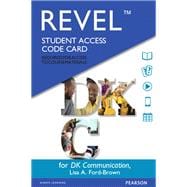The 2019 Revel™ re-release offers new and updated content and features.
For courses in Introduction to Speech Communication
Bring communication concepts to life through visuals that allow students to better make connections at a glance
Revel DK Communication brings communication concepts and theory to life through visual examples and graphics that allow students to better make connections at a glance. Author Lisa Ford-Brown combines straightforward descriptions, student-friendly examples, and practical information with the foundational content that students need — all presented within a compelling Dorling Kindersley design that facilitates an intuitive learning experience. Making the study of communication as dynamic, interactive, and engaging as communication itself, DK Communication equips students with the tools and confidence to be effective communicators in the classroom and beyond. The 2019 Revel re-release offers updated videos, assessments, and interactive figures, new chapter-opening video and writing activities, and new interactive summaries that facilitate knowledge retention.
Revel is Pearson’s newest way of delivering our respected content. Fully digital and highly engaging, Revel replaces the textbook and gives students everything they need for the course. Informed by extensive research on how people read, think, and learn, Revel is an interactive learning environment that enables students to read, practice, and study in one continuous experience — for less than the cost of a traditional textbook.
For courses in Introduction to Speech Communication
Bring communication concepts to life through visuals that allow students to better make connections at a glance
Revel DK Communication brings communication concepts and theory to life through visual examples and graphics that allow students to better make connections at a glance. Author Lisa Ford-Brown combines straightforward descriptions, student-friendly examples, and practical information with the foundational content that students need — all presented within a compelling Dorling Kindersley design that facilitates an intuitive learning experience. Making the study of communication as dynamic, interactive, and engaging as communication itself, DK Communication equips students with the tools and confidence to be effective communicators in the classroom and beyond. The 2019 Revel re-release offers updated videos, assessments, and interactive figures, new chapter-opening video and writing activities, and new interactive summaries that facilitate knowledge retention.
Revel is Pearson’s newest way of delivering our respected content. Fully digital and highly engaging, Revel replaces the textbook and gives students everything they need for the course. Informed by extensive research on how people read, think, and learn, Revel is an interactive learning environment that enables students to read, practice, and study in one continuous experience — for less than the cost of a traditional textbook.
NOTE: Revel is a fully digital delivery of Pearson content. This ISBN is for the standalone Revel access card. In addition to this access card, you will need a course invite link, provided by your instructor, to register for and use Revel.











